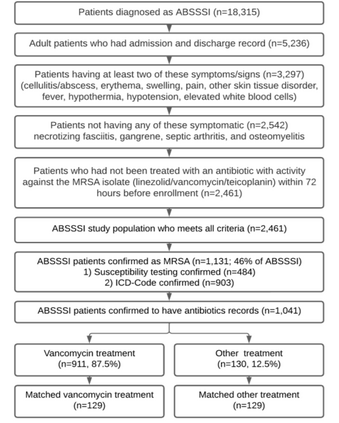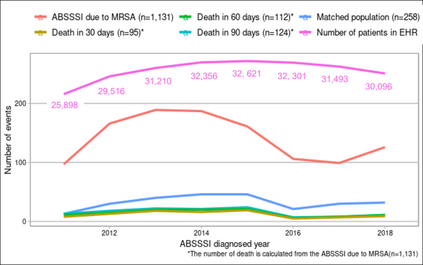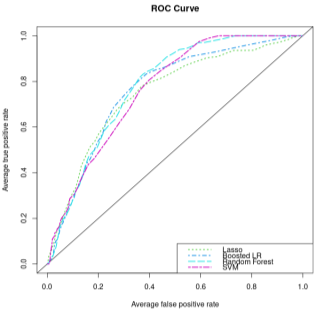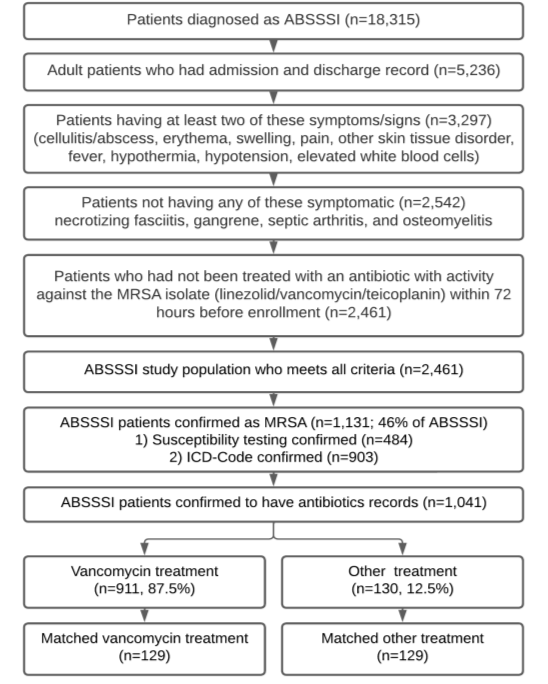Bacterial infections are responsible for high mortality worldwide. Antimicrobial resistance underlying the infection, and multifaceted patient's clinical status can hamper the correct choice of antibiotic treatment. Randomized clinical trials provide average treatment effect estimates but are not ideal for risk stratification and optimization of therapeutic choice, i.e., individualized treatment effects (ITE). Here, we leverage large-scale electronic health record data, collected from Southern US academic clinics, to emulate a clinical trial, i.e., 'target trial', and develop a machine learning model of mortality prediction and ITE estimation for patients diagnosed with acute bacterial skin and skin structure infection (ABSSSI) due to methicillin-resistant Staphylococcus aureus (MRSA). ABSSSI-MRSA is a challenging condition with reduced treatment options - vancomycin is the preferred choice, but it has non-negligible side effects. First, we use propensity score matching to emulate the trial and create a treatment randomized (vancomycin vs. other antibiotics) dataset. Next, we use this data to train various machine learning methods (including boosted/LASSO logistic regression, support vector machines, and random forest) and choose the best model in terms of area under the receiver characteristic (AUC) through bootstrap validation. Lastly, we use the models to calculate ITE and identify possible averted deaths by therapy change. The out-of-bag tests indicate that SVM and RF are the most accurate, with AUC of 81% and 78%, respectively, but BLR/LASSO is not far behind (76%). By calculating the counterfactuals using the BLR/LASSO, vancomycin increases the risk of death, but it shows a large variation (odds ratio 1.2, 95% range 0.4-3.8) and the contribution to outcome probability is modest. Instead, the RF exhibits stronger changes in ITE, suggesting more complex treatment heterogeneity.
翻译:细菌感染是造成全球高死亡率的原因。 感染背后的抗微生物抗药性是全球高死亡率的原因。 多方面病人的临床状态会阻碍抗生素治疗的正确选择。 随机临床试验提供了平均治疗效果估计,但对于治疗选择的风险分级和优化而言并不理想,即个性化治疗效果。 在这里,我们利用从南美学术诊所收集的大规模电子健康记录数据,以效仿临床试验,即“目标试验 ”, 并为急性细菌皮肤和皮肤感染的病人开发一个机器学习模型(ABSSSI ) 。 随机临床试验提供了平均治疗效果估计,但对于治疗选择的分级分级和优化治疗效果而言,ABSSSI-MSA是一个挑战性的条件,而治疗选项的分级分级分级分级分级分级分级和优化分级治疗效果 — 范性健康记录显示IBERF的分级比比值( Venticacinal Ventrial ) 数据( Ventrialal-LASSI) 和代谢机的分级测试显示, 最高比率值值的值值值值值值值值值值值值值值值值值值值值比值值比值值值比值比值比值比值为高。










